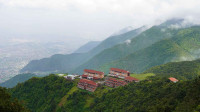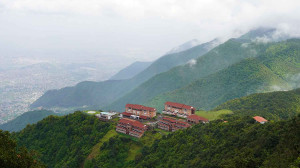Money
Bangladesh issues letter of intent to purchase 500 MW from Upper Karnali hydro project
The $1.5 billion hydropower project was awarded to India’s GMR Group in 2008 after an international competitive bidding process..jpg&w=900&height=601)
Sangam Prasain
The development will open doors for the Indian firm to make financing arrangements to build the power plant in western Nepal.
The project officials said the development of the project, which would also open doors for the first-ever trilateral power trade, has also ended suspicions that the project will never materialise.
The estimated cost of the export-oriented project located on the Karnali river in Surkhet, Dailekh and Achham districts is $1.5 billion and is expected to take about five years to complete.
The letter of intent was issued by the buyer, Bangladesh Power Development Board, following the approval of the Cabinet Committee on Government Purchase.
“The issuance of the letter of intent confirms all the key terms that we have agreed, including the tariff structure,” KK Sharma, the GMR-appointed project head of Upper Karnali in Nepal, told a press conference on Sunday.
The buying entity will enter into a power purchase agreement for the purchase of the electricity at the rate of 7.712 cents per unit for a period of 25 years, he said.
“We immediately have to issue two securities to get the project moving. We have to deposit a bank guarantee of $5 million and this security amount will remain valid until the power purchase agreement is signed,” Sharma said, adding at the time of the signing of the power purchase agreement, another $15 million bank guarantee has to be issued which would remain valid until the project is commissioned.
The project officials said that they plan to issue the bank guarantee within the next two weeks. “After the first bank guarantee is issued, the final drafting process of the power purchase agreement will proceed. After the draft is passed by Bangladesh’s Law Ministry and gets approved by its central bank, the agreement will be signed,” said Sharma, explaining the various processes involved.
The project team expects to sign the power purchase agreement within three months.
“The plan now is to go back to the lenders—the national and international banks and show the financial model of the project,” said Sharma.
He added: “We are hopeful this attractive power purchase agreement will take us to the next step for financial closure. Our discussion with a few foreign lenders, including Nepali banks have already started.”
Sharma said that around 20 percent of funds could come from the Nepali banks, based on their initial discussions with the potential lenders.
The run-of-the-river hydropower project was awarded to the Indian Group through an international competitive bidding process in 2008 on a build, own, operate and transfer model.
Nepal will receive 108 MW out of the remaining 400 MW for free, while GMR plans to sell the remainder to the Indian government.
At the end of the 25-year concession period, the project developer has to transfer the full ownership of the project to the Nepal government.
The power generated from the plant will be evacuated through a 400 kV double circuit transmission line up to the interconnection point of Power Grid Corporation of India, in India.
As per the proposal cleared by the Bangladeshi officials, the energy-hungry country will pay out a massive Tk381.60 billion (equivalent to Rs511.69 billion) over 25 years to procure 500 megawatts of electricity.
Bangladesh signed a memorandum of understanding with India’s NVVN to import electricity from the Upper Karnali scheme via India during Bangladeshi Prime Minister Sheikh Hasina’s visit to India in April 2017.
As the Indian laws don’t allow private developers to export electricity produced in third countries over Indian transmission lines, Bangladesh signed an MoU with the state-owned cross-border electricity trading agency, while GMR was a witness.
In the absence of a power purchase agreement, the Indian developer has already sought deadline extensions for financial closure, twice, from the Investment Board of Nepal, the facilitating agency.
The developer said it has yet not been able to acquire 12 hectares of unregistered and unidentified land parcels, out of a planned 49 hectares and is awaiting forest clearance permits from four community forest groups.




 7.98°C Kathmandu
7.98°C Kathmandu















